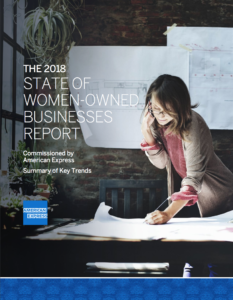 The 2018 State of Women-Owned Businesses Report
The 2018 State of Women-Owned Businesses Report
American Express
First published August 2018
Entrepreneurs solve problems, transform the way we do things, create jobs, spur economic growth and drive prosperity. Yet there is a significant gap between the number of women who start businesses and those who commit to growing them. Women are increasingly harnessing their entrepreneurial spirit and it is critical to encourage and support this behavior, eliminate obstacles, and facilitate the growth of their businesses. Unlocking the potential of women-owned businesses represents a powerful opportunity for economic growth.
What gets measured gets managed. To better understand the dimensions that drive the entrepreneurial process, American Express has for the past eight years provided annual updates on a variety of sociodemographic characteristics that influence the overall movement of the women-owned business sector. Some of these characteristics relate to the business owner, such as her race/ethnicity and motivations for starting the business, while others relate to the company, such as industry, firm size, and the geographical region in which the business is located.
The State of Women-Owned Businesses reports are used by the women’s enterprise development community — media, funders, entrepreneurial support organizations, elected officials, suppliers and customers and even women themselves–to inform practices, policies and advocacy efforts that encourage successful business outcomes, as well as to inspire and motivate women to start and grow businesses.
The projections in this report use the most recent (2012) Survey of Business Owners data from the U.S. Census Bureau as their foundation. Numbers are then adjusted for each year by the annual gross domestic product estimates as of January of the current year at the national, state and metropolitan levels and by industry.
To provide a historical view of women’s business ownership, the report compares some topline numbers from 2018 with numbers from 1972 — the first time the U.S. Census Bureau provided data on minority- and women-owned businesses and around the time baby boomers began reaching the age at which they might start a business. To observe how women-owned businesses changed from the recession to now, 2007 was compared to 2018.
Download Resource